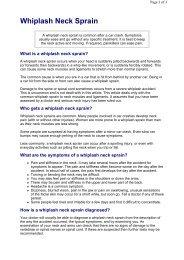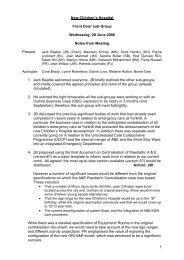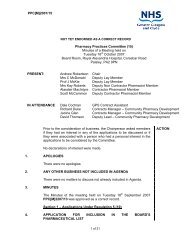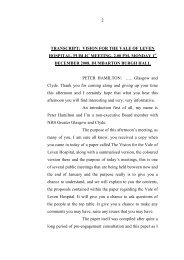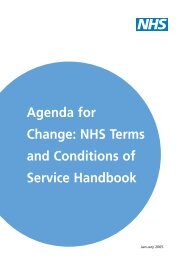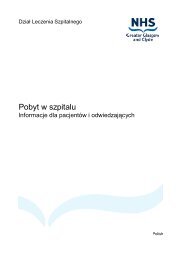Insertion & Maintenance of Indwelling Urinary Catheters The most ...
Insertion & Maintenance of Indwelling Urinary Catheters The most ...
Insertion & Maintenance of Indwelling Urinary Catheters The most ...
Create successful ePaper yourself
Turn your PDF publications into a flip-book with our unique Google optimized e-Paper software.
NHS GREATER GLASGOW & CLYDE<br />
Page 4 <strong>of</strong> 6<br />
CONTROL OF INFECTION COMMITTEE<br />
STANDARD OPERATING PROCEDURE (SOP)<br />
Effective<br />
from<br />
Nov 2009<br />
<strong>Insertion</strong> & <strong>Maintenance</strong> <strong>of</strong> <strong>Indwelling</strong> <strong>Urinary</strong> Review Nov 2012<br />
<strong>Catheters</strong><br />
date<br />
Version 2<br />
<strong>The</strong> <strong>most</strong> up-to-date version <strong>of</strong> this policy can be viewed at the following website:<br />
www.nhsggc.org.uk/infectioncontrol<br />
• Patients with long-term catheters must have an individual catheter<br />
regimen designed to minimise problems <strong>of</strong> blockage and<br />
encrustation. Care should be planned to minimise (eliminate)<br />
emergency catheterisations out-<strong>of</strong>-hours.<br />
• Record input and output where appropriate.<br />
• Monitor and record urine flow, colour and debris.<br />
• Monitor and record patient’s temperature where appropriate.<br />
• Send a specimen <strong>of</strong> urine for culture if patient is feverish,<br />
develops abdominal pain or urine appears cloudy using an aseptic<br />
technique via the designated sampling port not catheter bag.<br />
• Provide routine personal hygiene to maintain cleanliness –<br />
antiseptics are not required.<br />
• Do not change catheters unnecessarily or as part <strong>of</strong> routine<br />
practice. <strong>Catheters</strong> should be changed in accordance with<br />
manufacturers’ guidelines and the needs <strong>of</strong> the patient.<br />
• Do not add antiseptic or anti-microbial solutions into urinary<br />
drainage bags.<br />
• Do not use bladder irrigation, installation or washouts to prevent<br />
catheter associated infection.<br />
• Do not use catheter maintenance solutions to prevent UTI unless<br />
prescribed by an urologist.<br />
• An overnight drainage bag can be attached to the day bag/ leg bag<br />
to facilitate drainage overnight.<br />
• For patients going home with catheters in situ, educate the patient<br />
and carers on fluid intake, hand hygiene before and after catheter<br />
and catheter bag contact, emptying and changing <strong>of</strong> urinary<br />
catheter drainage system, and daily catheter cleansing regimes.<br />
• If pre-connected catheters are in use the initial bag can remain<br />
connected for two weeks.<br />
If problems develop with blockage, reduced flow, cloudiness, pain, bypassing or<br />
haematuria refer immediately to Medical/ Specialist Nursing Staff for advice on<br />
further action.<br />
<strong>The</strong> <strong>most</strong> up-to-date version <strong>of</strong> this policy can be viewed at the following website:<br />
www.nhsggc.org.uk/infectioncontrol





